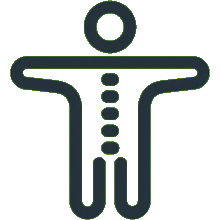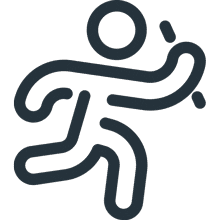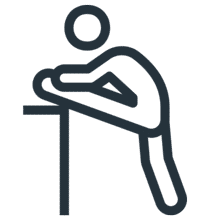
CHEERS TO 2025!
As we bid farewell to another year and embrace the fresh start of a new one, many of us find ourselves contemplating resolutions. Whether...
Read moreTouch football players are constantly engaging in high-intensity movements such as:
Quick bursts of speed are essential, especially when breaking away from defenders or chasing the ball.
The ability to swiftly change direction, or "change of pace," is often the difference between scoring a try or being tagged.
Although touch football is a non-contact sport, leaping to intercept a pass or jumping off the line to make a touch requires strong and stable legs.
Explosive starts and the ability to slow down quickly to avoid running out of bounds or to prepare for the next move rely heavily on lower body strength.
All of these actions require well-developed lower limb muscles and a stable base to produce power, maintain speed, and quickly alter movement patterns.
Strength in the lower limbs—especially in the quadriceps, hamstrings, calves, and glutes—is essential for generating forceful movements. Here’s how lower limb strength contributes to key aspects of touch football performance:
The faster and more explosively a player can move, the more effective they become on the field. Lower body strength is directly correlated with the ability to generate power from the legs, whether it’s propelling the body forward in a sprint or powering through a change of direction. Strong muscles in the quads, hamstrings, and calves ensure quick and efficient movement, which is critical for evading defenders and creating space for the player with the ball.
Touch football is all about reacting quickly to the ever-changing flow of the game. Players frequently pivot, dodge, and perform sharp directional changes. Lower limb strength helps facilitate these movements by providing a solid foundation for the body to shift directions rapidly without losing balance or control. Strong and stable ankles, knees, and hips help minimize the likelihood of being “caught out” during these sharp cuts or sudden stops.
During a touch football game, players often find themselves sprinting multiple times over a short period. Lower limb strength aids not just in immediate power, but also in muscle endurance – allowing players to maintain high performance throughout the duration of the game. Strong muscles resist early fatigue and help maintain explosive power and control even when energy levels begin to dip.
While strength is crucial for performance, stability in the lower limbs is just as important for minimizing injury risk. Touch football is a non-contact sport, but players still face the risk of strains, sprains, and other injuries, particularly when making rapid movements.
The knees, ankles, and hips must all be able to withstand the forces placed on them during intense activity. For instance, sudden decelerations or awkward landings can lead to knee injuries, such as ACL or MCL tears. A stable lower limb reduces the risk of these injuries by allowing the muscles and ligaments to effectively control joint movements, preventing excessive stress on vulnerable areas.
A player’s ability to maintain balance under various conditions—whether during a sprint, a pivot, or an aggressive change of direction—is fundamental for both performance and safety. Strong and stable lower limbs support coordination and postural control, reducing the likelihood of tripping, twisting an ankle, or sustaining other balance-related injuries.
In touch football, players repeatedly perform movements such as sprinting, turning, and jumping. Without proper lower limb strength and stability, players may rely on improper mechanics or overcompensate in other areas, leading to overuse injuries like tendinitis, shin splints, and stress fractures. A well-conditioned lower limb structure helps absorb repetitive stress and distribute forces evenly, which lowers the risk of these injuries.
Lower limb strength and stability are not just beneficial for improving performance—they are essential for protecting players from injury. Whether you’re trying to sprint faster, change direction quickly, or stay injury-free throughout the season, developing strong, stable lower limbs is crucial.
By prioritizing lower body strength training, maintaining joint stability, and focusing on balance, touch football players can enhance their performance while ensuring longevity in the sport. See our physios to learn more about building robust and well-conditioned legs, to allow yourself to be a more confident player when competing at your highest level, knowing that their body is capable of handling the demands of the game.
If you’re a touch football player or coach, consider joining our exercise led prevention classes to ensure you are implementing a comprehensive strength and stability program into your training regimen. It’s one of the best investments you can make for both performance and injury prevention—ensuring you stay at the top of your game for years to come.

As we bid farewell to another year and embrace the fresh start of a new one, many of us find ourselves contemplating resolutions. Whether...
Read more
The Importance of Lower Limb Strength and Stability for Performance and Injury Prevention in Touch Football Players Touch football is a dynamic and fast-paced sport,...
Read more
Muay Thai Champion In the fiercely competitive world of Muay Thai, grit, determination, and unrelenting passion define champions. One such athlete has captured the hearts...
Read more
A common misconception is that physiotherapists are only able to help with injuries. A physiotherapist has a wide range of skills that allows them...
Read more
And the role Physiotherapy can play in managing it. Joint hypermobility is a very common presentation that our clinicians treat at PEAK and it is...
Read more
Meet Luke, a PEAK athlete with a story we have all heard before – lower back pain that leaves you completely debilitated for days. Luke...
Read more
Conquering the Blackall 100km In the world of endurance sports, the journey of an athlete is often as inspiring as the race itself. One athlete...
Read more
Keen on Getting into Running in the New Year? Let’s Do It Without the Pesky Knee Pain! The new year is here, and with it...
Read more
Embracing Growth, Fitness, and Self-Defense When most people think of martial arts, they often picture kids in uniforms or action movie stars in fight scenes....
Read more
2024 Room Nomination Winners Meet Krystle and Joe, who in 2024 made PEAK history winning a joint room nomination! At PEAK we have an annual...
Read moreNot exactly what you're looking for?
View all articles

















Can't find what you're after?
View all ServicesOr email the PEAK team at info@peakssc.com.au
To make a booking outside of business hours, please use our form by clicking here.
To make a booking outside of business hours, please use our form by clicking here.